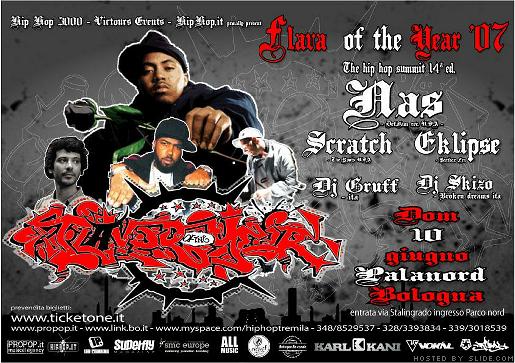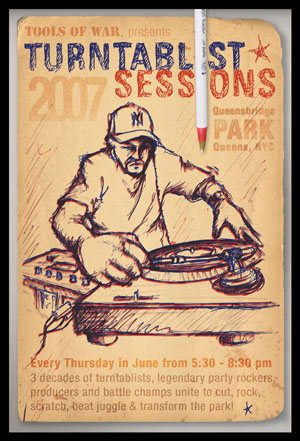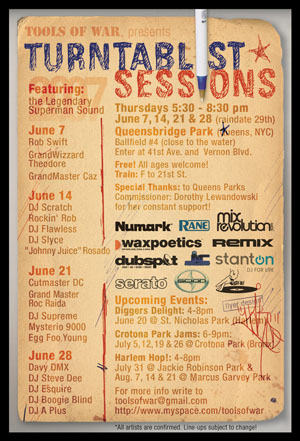
copertina dell’lp di Bam & the Millennium Of The Gods – Dark Matter Moving At The Speed Of Light
dalla pagina http://www.hiphopreader.it/show.php?mode=articolo&id=14
Hip Hop History Files [1973 – 1979] # 2
Afrika Bambaataa e la Universal Zulu Nation
Immaginate una ripresa dall’alto del Bronx River Project, un enorme
complesso popolare composto da dodici edifici di cemento massiccio
situato vicino ad altri due giganteschi magazzini umani, le Bronxdale
Houses e le James Monroe Houses. Immaginate che la ripresa si restringa
dirigendo la vostra attenzione verso il centro comunitario del
complesso situato al centro di quell’ovale formato da quei mostri
verticali. Immaginate ora che la ripresa lentamente si sposti verso
l’edifico sulla sinistra per fermarsi su una finestra al primo piano
con due casse che sparano musica a tutto volume dietro alle quali si
muove un giovane afro-americano con una personalità magnetica e una
reputazione degna del massimo rispetto nelle strade del Bronx degli
anni Settanta.
A questo punto immaginate che la nostra storia abbia inquadrato il suo
protagonista: Afrika Bambaataa. In un’area dove in ogni project esiste
una gang, dove anche poche centinaia di metri rappresentano una terra
senza legge né dio, dove qualche isolato costituisce un confine
invalicabile, Bambaataa era pronto a portare la sua crew a feste dove
quei giovani non avrebbero mai immaginato di poter ballare, in projects
dove non avrebbero mai pensato di poter passare del tempo e tanto meno
divertirsi e socializzare. Ancora incredulo a distanza di trent’anni
Jazzy Jay racconta: “Bambaataa diceva che c’era una festa a Bronxdale.
Prende la sua borsa con le cassette musicali e mentre fa per andare ci
sono almeno 40/50 persone a muoversi con lui. Bam era il leader.
Ovunque andassimo rappresentavamo il Bronx River (…) ovunque ci fosse
una festa, ecco Bam ed ecco il suo entourage. Ecco l’esercito. Ovunque
Bam andasse lì c’era il divertimento e quello era il luogo dove dovevi
assolutamente trovarti!” [1]
Afrika Bambaataa è una figura cruciale per la nascita e la diffusione
della cultura Hip Hop, la scintilla che ha scatenato l’incendio
culturale che ancora plasma l’immaginario culturale contemporaneo.
Molti elementi associati alla cultura Hip Hop sembrano trarre la loro
stessa esistenza dall’aurea mitica associata alla figura di Bambaataa –
original gangster, archeologo del breakbeat, mistico interplanetario,
afro-futurista, attivista Hip Hop, griot del ventunesimo secolo.
Bambaataa portò la musica e la cultura della gioventù nera e latina
all’attenzione della scena artistica underground e punk rock di
Manhattan distruggendo virtualmente quei muri di segregazione e quegli
isolati di marginalità sociale che caratterizzavano le comunità urbane
povere durante i primi anni settanta, portando la cultura Hip Hop in
tutta la città, la nazione e oltre il pianeta del Rock.
Un viaggio oltre il Pianeta del Rock
Dei tre re che compongono la trinità della musica Hip Hop – Kool
DJ Herc, Afrika Bambaataa e Grandmaster Flash – la storia più avvincente è
quella di Bambaataa Kahim Asim.
Fu il warlord dei Black Spade che diventò il Master of records; lo
sciamano che faceva ballare oltre duecento duri fondendo la musica dei
Kraftwerk, Fela Anikulapo-Kuti, il tema della Pantera Rosa, i Rolling
Stones e i Magic Disco Machine; il fondatore della Universal Zulu
Nation, la prima organizzzazione Hip Hop che cercò di educare la
propria gente facendola divertire; il predicatore del gospel dei “4
elementi” – DJing, MCing, B-boying e Graffitti Writing; il missionario
che ha portato il messaggio dell’Hip Hop ai quattro angoli del globo.
[2]
Sebbene la sua storia sembri ben documentata molti sono gli aspetti
della vita di Bam che rimangono misteriosi a partire dal suo nome e
dalla data di nascita. La nostra storia, però, non si focalizza su
questi particolari bensì su un momento di trasformazione personale e
collettiva che ci permetterà di mettere a fuoco la figura di Afrika
Bambaataa per comprenderne l’importanza del suo credo visionario e
l’impatto che ebbe tra i giovani del suo quartiere e per le generazioni
future.
Nel contesto sociale che caratterizzava il Bronx dell’epoca era quasi
inevitabile finire in una gang. Fin dal 1968 erano sorti gruppi di
stampo tribale che avevano rimpiazzato le gang degli anni Cinquanta,
spazzate via dall’ondata di eroina dei tardi anni Sessanta. La più
grande è quella dei Black Spades e i suoi membri vestivano con jeans,
giubbotti Levi’s, cinture militari e anfibi neri. Ci si univa a loro
perché se ne ammirava lo stile, perché indossarne i colori assicurava
protezione o semplicemente perché si era adolescenti.
Nel 1971, l’anno della tregua tra le gang del Bronx, il giovane
Bambaataa si trova costretto a frequentare la Stevenson High School; la
scuola è situata in un area per lo più bianca e Bam è uno dei tanti
giovani neri spediti in scuole bianche come parte di un programma di
desegregazione razziale, denominato Busin. All’apparire dei primi
giovani di colore, molti dei quali appartenenti alla gang dei Black
Spades, la scuola diventò il terreno di un violento scontro razziale,
il confine sanguinoso del processo d’integrazione.
Il giovane Bambaataa è nominato warlord dei Black Spades dal presidente
della gang Bam Bam che stima il ragazzo per la sua capacità di passare
da un project all’altro, da un territorio all’altro. Come l’amico Jay
McGluery ha raccontato al giornalista Steva Hager, “C’erano talmente
tante gang e lui conosceva almeno cinque membri in ogni gang. Ogni
volta che scoppiavano delle tensioni, provava sempre a intervenire per
risolverle”[3] . Mentre le tensioni razziali crescono, Bambataa guida i
suoi uomini contro le gang bianche in scontri che si allargano a tutta
l’area di Soundview e West Farms. Sebbene non si tirasse mai indietro
davanti agli scontri, la pace tra le gang del Bronx che aveva riunito
la gioventù nera e latina ebbe un profondo impatto su Bam che intuì di
dover utilizzare il proprio carisma e le proprie energie per costruire
qualcosa di positivo per la propria gente.
Qualche anno prima, il mito nascente di DJ Kool Herc aveva offerto a
Bambaataa l’opportunità che cercava… altri due ex Black Spades avevano
iniziato a fare i DJ – Kool DJ D nel project del Bronx River e Disco
King Mario a Bronxdale. Dopo aver toccato l’apice nel 1973, le gang
scomparvero in fretta. La crescente popolarità di graffittismo e
breakdance offriva ai ragazzi modi meno pericolosi per mettersi in
mostra, inoltre le ragazze si erano stufate dello spirito guerresco dei
loro uomini. Il loro messaggio sembrava essere: “O la piantate o vi
piantiamo”. Bambaataa tagliò definitivamente i ponti con le gang nel
gennaio del 1975, quando il suo migliore amico Soulsky venne ucciso
dalla polizia. Come regalo per la promozione, quello stesso anno, la
madre gli regalò un sound system. Il 12 novembre del 1976 diede la sua
prima festa ufficiale come DJ al Bronx River Community Center[4].
“Quando sono diventato un DJ avevo già un esercito al mio seguito
quindi era automatico che le mie feste sarebbero state stracolme di
gente”[5].
Quello stesso anno forma la Bronx River Organization come alternativa
alle gang che infestavano il Bronx – nel 1975 prenderà il nome di
Universal Zulu Nation – la prima organizzazione comunitaria dedita
all’educazione e al miglioramento delle condizioni di vita nelle
comunità di colore, all’insegnamento della cultura Hip Hop e alla sacra
religione del divertimento. Come è solito ripetere Bambaataa: “Questa è
un’organizzazione. Non siamo una gang. Siamo una famiglia. Non creiamo
problemi. Se i problemi arrivano loro, allora combatti fino alla
morte”[6].
I party, le feste sono la nuova moda nel Bronx e Bam crea un’alleanza
strategica con la Chuck Chuck City Crew di Bronxdale e con le crew di
molti altri project. Mentre Kool DJ D, Disco King Mario e altri DJ del
Bronx come DJ Tex suonano l’uptempo disco music molto popolare alla
radio, Bambaataa è affascinato dalla ricerca del break di Kool Herc. Il
suono di Bam è l’equivalente delle sue straordinarie capacità
relazionali: la sua selezione musicale è così eclettica e inclusiva da
riflettere le aspirazioni dell’organizzazione che aveva creato. Mixa i
Grand Funk Railroad e i Monkeys con Sly and James e i discorsi di
Malcolm X; suona salsa, rock e soca con lo stesso entusiasmo dei dischi
funk e soul con cui fa impazzire la gente. Crea la sua fama come il DJ
più eclettico della scena. Ogni weekend Afrika Bambaataa diventa il
sacerdote che presiede un sacro rituale fatto di divertimento e ritmo
il cui motto è “Pace, Amore, Unità e Divertimento”.
“Tiravamo fuori dei break impensabili”, s’infervora Bam. “Mentre gli
altri DJ suonavano per quindici o anche venti minuti, noi li cambiavamo
dopo pochi secondi o un paio di minuti. Non facevo mai andare un break
oltre un paio di minuti, a meno che non avesse un tiro così funky da
mandare la gente fuori di testa: in quel caso lo prolungavamo per due,
tre, quattro minuti… Suonavano tutti i tipi di musica. Ne trovavo
ovunque! ”[7]. Dal synth pop europeo alle sigle dei cartoni animati
passando per l’acid rock: l’Hip Hop è stato affamato ed eclettico fin
dagli inizi. A Bam non interessava il genere dei dischi che metteva su,
ma solo la loro efficacia come componenti sonori e l’effetto che
avevamo sulla pista.
Eccoci arrivati agli anni Ottanta con Bam a capo di un esercito
composto da DJ, MC, b-boy e b-girl, writer e da tutti quei giovani che
affollano le sue feste. Ciò che stavano facendo non aveva ancora un
nome ma sia nelle jam nei parchi che in una festa in un club, Bambaataa
ha trasformato le feste di Herc in cerimonie di un nuovo credo, un
credo che rappresenta, suona e appare come la società nella quali quei
giovani avrebbero voluto vivere.
The Legacy
“Zulu Nation non è una gang. È un’organizzazione d’individui alla
ricerca di successo, pace, conoscenza, comprensione e una vita onesta.
I membri Zulu devono cercare un modo per sopravvivere positivamente in
questa società. Le attività negative appartengono ai malvagi. La natura
animale rappresenta la natura negativa. Gli Zulu devono essere
civilizzati”. Così recitano i Principles of the Universal Zulu Nation,
parte prima e seconda.
Invece di una piattaforma politica in dieci punti, la Universal Zulu
Nation offriva le Seven Infinity Lessons, un vero e proprio codice di
comportamento per tutti i membri dell’organizzazione. Come durante i
suoi DJ set, Bambaataa fonde con il massimo della libertà e
dell’eclettismo influenze e stimoli differenti, alcuni familiari, altri
arcani per offrire al mondo la prospettiva privilegiata dei Bronx River
Project sulle origini dell’Hip Hop.
Le Infinity Lessons sono presentate in forma di domanda e risposta con
tanto di glossario in maniera del tutto simile alla Nation of Islam e
ai 5Percenter dai quali presero il riferimento alle origini regali del
loro passato africano ma non l’impulso alla separazione razziale;
richiamarono il concetto e la pratica dell’autodifesa espresso dalle
Pantere Nere ma non ripresero l’impegno contro la disoccupazione e per
degli alloggi decenti. Cosa fondamentale però, le Infinity Lesson sono
un testo in continua evoluzione capaci di adattarsi all’evolversi dei
tempi.
Le Infinity Lesson sembrano a una prima lettura un casino allucinante a
metà tra un testo di carattere religioso e un manifesto politico privo
di alcuna visione strategica. Tutto ciò però ha davvero poca importanza
poiché gli Zulu celebrano l’istinto della sopravvivenza e della
creazione, la gioventù e libertà come atti rivoluzionari e le sedi
dell’organizzazione ormai contano rappresentanze in tutto il mondo.
Essere con la Zulu Nation significa avere potere, rispetto ma
soprattutto tanto divertimento.
Bam ebbe una notevole importanza a livello sociologico, perché offrì un
modello di aggregazione alternativo post gang basato sulla musica e il
ballo piuttosto che sulla violenza, mise fine alle controversie tra le
varie crew e creò una rete globale di fan della cultura Hip Hop.
u_net, hiphophistorian.
Note:
[1]Jim Fricke, Charlie Ahearn, Yes Yes Y’All, EMP,2002, p. ???
[2] Vedi Jeff Chang, Can’t Stop Won’t Stop, St Martins Press, New York, 2005, p. 90.
[3] Steve Hager, Hip Hop: The Illustrated History of Breakdancing, Rap
Music and Graffiti, St Martins Press, New York, 1984, pp. 9-10.
[4] Bill Brewster, Frank Broughton, Last Night a DJ Saved My Life, Fazi Editore, Roma, 2005, pp. 267.
[5] Jeff Chang, Can’t Stop Won’t Stop, St Martins Press, New York, 2005, p. 96
[6] Ibidem
[7] Bill Brewster, Frank Broughton, Last Night a DJ Saved My Life, Fazi Editore, Roma, 2005, pp. 268.
info: http://www.hiphopreader.it/























